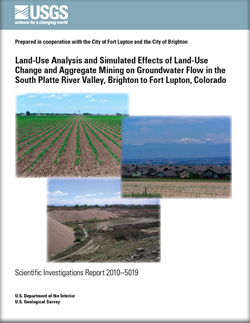Scientific Investigations Report 2010–5019

Land use in the South Platte River valley between the cities of Brighton and Fort Lupton, Colo., is undergoing change as urban areas expand, and the extent of aggregate mining in the Brighton–Fort Lupton area is increasing as the demand for aggregate grows in response to urban development. To improve understanding of land-use change and the potential effects of land-use change and aggregate mining on groundwater flow, the U.S. Geological Survey, in cooperation with the cities of Brighton and Fort Lupton, analyzed socioeconomic and land-use trends and constructed a numerical groundwater flow model of the South Platte alluvial aquifer in the Brighton–Fort Lupton area. The numerical groundwater flow model was used to simulate (1) steady-state hydrologic effects of predicted land-use conditions in 2020 and 2040, (2) transient cumulative hydrologic effects of the potential extent of reclaimed aggregate pits in 2020 and 2040, (3) transient hydrologic effects of actively dewatered aggregate pits, and (4) effects of different hypothetical pit spacings and configurations on groundwater levels. The SLEUTH (Slope, Land cover, Exclusion, Urbanization, Transportation, and Hillshade) urban-growth modeling program was used to predict the extent of urban area in 2020 and 2040. Wetlands in the Brighton–Fort Lupton area were mapped as part of the study, and mapped wetland locations and areas of riparian herbaceous vegetation previously mapped by the Colorado Division of Wildlife were compared to simulation results to indicate areas where wetlands or riparian herbaceous vegetation might be affected by groundwater-level changes resulting from land-use change or aggregate mining. Analysis of land-use conditions in 1957, 1977, and 2000 indicated that the general distribution of irrigated land and non-irrigated land remained similar from 1957 to 2000, but both land uses decreased as urban area increased. Urban area increased about 165 percent from 1957 to 1977 and about 56 percent from 1977 to 2000 with most urban growth occurring east of Brighton and Fort Lupton and along major transportation corridors. Land-use conditions in 2020 and 2040 predicted by the SLEUTH modeling program indicated urban growth will continue to develop primarily east of Brighton and Fort Lupton and along major transportation routes, but substantial urban growth also is predicted south and west of Brighton. Steady-state simulations of the hydrologic effects of predicted land-use conditions in 2020 and 2040 indicated groundwater levels declined less than 2 feet relative to simulated groundwater levels in 2000. Groundwater levels declined most where irrigated land was converted to urban area and least where non-irrigated land was converted to urban area. Simulated groundwater-level declines resulting from land-use conditions in 2020 and 2040 are not predicted to substantially affect wetlands or riparian herbaceous vegetation in the study area because the declines are small and wetlands and riparian herbaceous vegetation generally are not located where simulated declines occur. See Report PDF for unabridged abstract. |
First posted June 18, 2010 For additional information contact: Part or all of this report is presented in Portable Document Format (PDF); the latest version of Adobe Reader or similar software is required to view it. Download the latest version of Adobe Reader, free of charge. |
Arnold, L.R., Mladinich, C.S., Langer, W.H., and Daniels, J.S., 2010, Land-use analysis and simulated effects of land-use change and aggregate mining on groundwater flow in the South Platte River valley, Brighton to Fort Lupton, Colorado: U.S. Geological Survey Scientific Investigations Report 2010–5019, 117 p.
Abstract
Introduction
Groundwater Hydrology
Land-Use Analysis
Simulation of Groundwater Flow
Simulated Effects of Land-Use Change and Aggregate Mining on Groundwater Flow
Model Limitations and Transferability of Results
Summary and Conclusions
Acknowledgments
References Cited
Appendix—Color infrared aerial photographs used by this study to map wetlands and surface water in the South Platte River valley, Brighton to Fort Lupton, Colorado